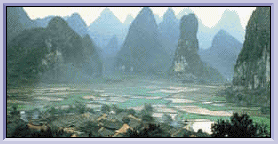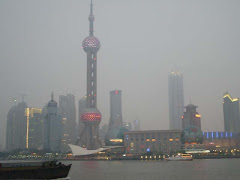Tuesday, February 17, 2009
China has overcome the "bad old days" of backyard furnaces from the Great Leap era, and its modern steel-producing capacity is extremely robust. In 2008 China produced about 500 million tons of steel, and China's domestic steel consumption was nearly 430 million tons (figures from the "China Economic Net" web-site 2/16/09). Much of China's steel production goes into domestic construction, which was rising steadily for about 15 years UNTIL last year. At one point, Chinese was buying up much of the world's scrap steel to make up for the gap in its own production. However, the price of steel has fallen since the end of last year, and the number of these domestic construction projects has fallen as well.
In 2008 the US steel industry exported 12 million tons of steel from the country's overall production (the figure for which I can't locate right now), which is less than half the Chinese export figure, but I'm not certain how much US steel went to China and how much Chinese steel last year came to the US. I assume that higher quality US steel must have a market in China for specialized uses, while cheaper Chinese steel makes economic sense in some US markets, thus the interdependence of the two industries. Manufactured goods rather than steel play the most important parts in China's exports to the US. However, China needs to maintain all domestic production for political and social reasons as well. To maintain the economic growth necessary to prevent social unrest in China, which some analysts state is over 9%, the Beijing government is very wary of any protectionist suggestions from the US. Upsetting the current import/export volumes between the US and China could have a dramatic effect on Chinese society.
China does engage in some economic protectionism, but the country currently does not maintain high tariffs, compared to other emerging economies. In 1982 China imposed a general import tariff of 56% while today the figure (post-WTO membership) is close to 15% (cited by China economist Nicholas Lardy, formerly at alma mater, the University of Washington). China is also by some measure the world's third largest importer of foreign-made goods. The "Buy American" debate seems to be a political matter that doesn't directly reflect the economic reality of the Sino-US relationship.
On the New York Times web-site, there is an on-going debate of this issue that you might find interesting: http://roomfordebate.blogs.nytimes.com/2009/02/11/that-buy-american-provision/
Sunday, January 13, 2008

Even after returning home from our year in
Last year in
Walking past the construction sites we entered a short stretch of old
Increasingly, however, younger Beijingers with means are fleeing such old neighborhoods for the material comforts of upscale housing complexes such as the one in which we lived or to more landscaped compounds beyond the third and fourth ring roads. Twenty years ago everyone I knew was concerned with economic improvement but was uncertain how to proceed, given that the central government had only recently been permitted such self-enrichment. Now, with economic prosperity not only permitted but almost mandated in the constitution, people are far more concerned about its cost, personal and environmental. Even ten years ago the late autumn sky was often blue with only the yellowish tint of charcoal haze produced by the millions of briquette-burning stoves throughout the city. Today a bluish-white cloud of exhaust often settles on downtown
Monday, February 13, 2006
The narrator Peter Krogh began this program by questioning whether China was really ready to take a place on the world stage, given the current state of its economic infrastructure, the degree of government intervention in economic and financial matters that is still practiced in China and the variety of social and environmental problems that China faces in the near future. The next 20 minutes of this program was an attempt to answer this question.
Most of the program covered the key speakers at a recent Foreign Policy Association's World Leadership forum in New York. The forum's moderator noted that the rise of China has been called the single most important geopolitical event in the 21st century, suggesting that the US had better pay greater attention to this strategic relationship than has been the case in the past. The first speaker, former ambassador to China James Sasser, spoke of a China that was ready to work in concert with other nations, abandoning old tendencies toward isolationism for an engaged diplomatic position on issues that affected China directly (the situation on the Korean peninsula was one important example).
The next speaker Prof. Yashang Huang from MIT argued that the economic competition between the US and China is highlighted in the western media in a way that distorts the real relationship and hides the actual economic benefits that the US enjoys as a result of this relationship. CNN's Lou Dobbs was singled out as a purveyor of this lop-sided picture of current Sino-America relations. Professor Huang argued that, for example, he can afford the mortgage of his home in Boston largely because the Chinese government is busy buying up US T-bills to offset the deficit spending. I don't know if dependence on a foreign government for debt relief is necessarily my preferred path toward the balancing of the national budget, but Professor Huang's point certainly describes the current state of our national fiscal situation.
Finally, Congressman Mark Kirk of Illinois contended in his presentation that the private sector has woken up to the benefits of engaging China more directly well before the public sector, in particular government official with the Washington "belt," has given any real attention to the affects the rise of China has had on the US economy or made any corresponding adujstment in the US oficial stance toward China ("threat" has not yet given way to "opportunity").
All three speakers spoke of changes in China as bringing generally positive results in regional stability and global economic activity. The negative affects of this growth, including environmental degradation that spills over China's borders, economic dislocation (over-hyped or not!) that has affected economies world-side, and the potential for military confrontations over issues involving China's borderlands (Taiwan, Xinjiang, etc.), received little attention. Nevertheless, the speakers brought more depth to the issues they addressed than one receives when the same topic are covered in nightly newscasts.
Without looking one step ahead to predict where and when Beijing's leadership wishes for China to take up its "mandate" as a worldpower, we will always be reacting wildly to China's rise to the world stage without any hope of shaping its path upwards.
Click to watch: The Rise of China on the World Stage
Seeking Truth from Facts
Friday, January 13, 2006

Through the Late Imperial period, the Chinese frontier policy served the “centering” function of the traditional tributary system. Ideally, the Chinese court’s southwestern frontier administration sought to introduce to its “uncultured” inhabitants all the benefits of life at the “civilized” center. To be precise, the Chinese court managed its southwestern frontier at a fair distance through the successive systems of “loose rein (jimi 羁糜) and, by the early Ming, “native chieftain (tusi 土司)” regulation. These frontier systems of administration were intended to signal to those communities “beyond” the civilized core to join the center. These systems were not dependent on the extraction of local resources for its continuation. Gifts from the frontier were regarded as appropriate acts of submission, and so they were placed in the context of the larger tribute system. Despite occasional problems, Chinese leaders deemed these systems of frontier management sufficient for many centuries. As Robert Jenks notes in his study of the Miao of Guizhou, Chinese officials saw no reason to abolish the tusi system as late as the Yongzheng period (mid-18th century), and that many hereditary positions remained even into the 20th century.
